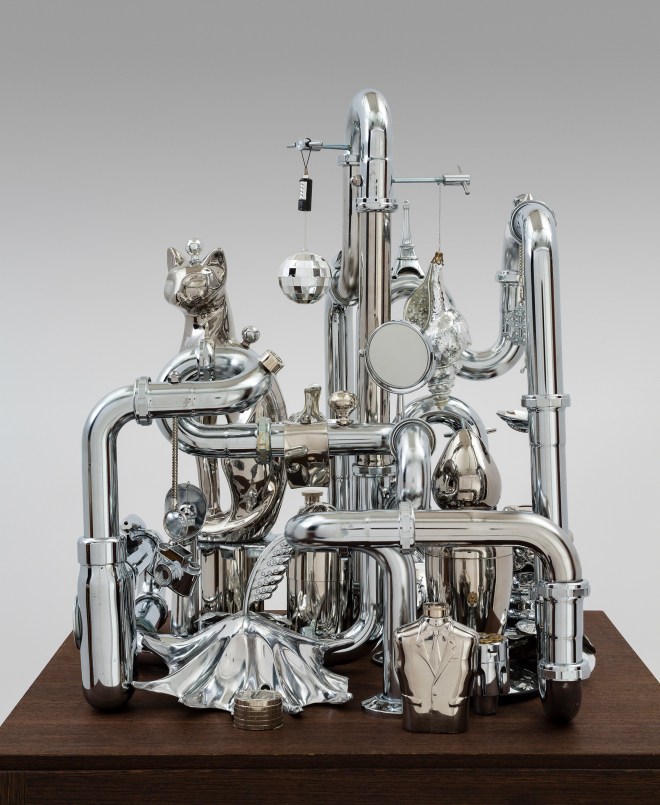
Baskin views the market-driven economy and cultural milieu of the 17th-century Netherlands as a sort of parallel world and precursor of our own hyperbolic investment-based economy, formulating it as an “art-historical model” through which he examines the superficiality of mass consumption. He is particularly informed by the “vanitas” paintings of artists such as Adriaen van Utrecht, which fuse an exalted materiality with a sense of anxiety and doubt by juxtaposing a cadre of sumptuous luxury items with memento mori, such as skulls and angels.
The work in Consumption of Failure embodies a similar duality of material lust and a sort of moral hesitance; as dimensional “vanitas” images, the work contains a network of objects and their attendant associations, raising a critique of contemporary consumerism and economic insatiability through this material dialogue. In Cat, the exotic fruits, animals, and flowers favored by Flemish school painters give way to objects of our own expanded, globalized economy. Baskin's own artistic practice complements the broader themes of his work, as he uses primarily store-bought items in the assemblages, emphasizing his own role as a consumer.
The bronze sculptures, inspired by “Tulip Mania,” the first recorded futures market bubble, provide a physical analog for the process of economic inflation and crash. Titled Euphoria, Doubt, Denial, Disillusion, and Realism, they depict the five stages economists equate to the rise and fall of an economic bubble (and incidentally the five stages of the grieving process). Cast in bronze from actual tulips, the languid arches of the sculptures form a sort of poetics of failure. Baskin delves further into his model with a series of prints of tulips embellished with gold leaf; questioning how value is defined, particularly in regard to the tulip, a rather ordinary item that came to command extreme prices, they reflect the irrational and almost metaphysical foundations of economic desire.
David Baskin received a BFA from The Cooper Union in 1987. One-person exhibitions include Arts Brookfield, Grace Building Lobby, NYC, Freight+Volume, NY, NY; Sculpture Center, NY, NY; Ingalls & Assoc., Miami, FL; and Black and White Gallery, Brooklyn, NY. Selected group exhibitions include the Brooklyn Museum of Art, Brooklyn, NY; Marianne Boesky Gallery, NY, NY; Carolina Nitsch, NY, NY; Carraige Trade, NY, NY; Pavel Zoubok Gallery, NY, NY; Munson Williams Proctor Arts Institute, NY, NY; Triennial Design Museum, Milan, Italy; Musée d'arts Appliqués Contemporains, Lausanne, Switzerland; Galerie Erna Hecey; Brussels, Belgium; Leslie Heller Gallery, NY, NY; Rudolf Budja Gallery, Salzburg, Austria; and Flag Art Foundation, NY, NY. Honors and awards include McDowell Fellowship, NH; Pollock-Krasner Foundation, Yaddo Fellowship, NY; and a commission through Brookfield Properties for a lobby installation at the Grace Building, NY, NY. He has taught at The Cooper Union School of Art, New York Institute of Technology, and was a visiting critic at the School of Visual Arts, NY, NY; Pratt Institute, Brooklyn, NY; and the University of Buffalo, NY. David Baskin was one of the original founders of the Brooklyn-based non-profit art organization Smack Mellon. He lives and works in NYC.